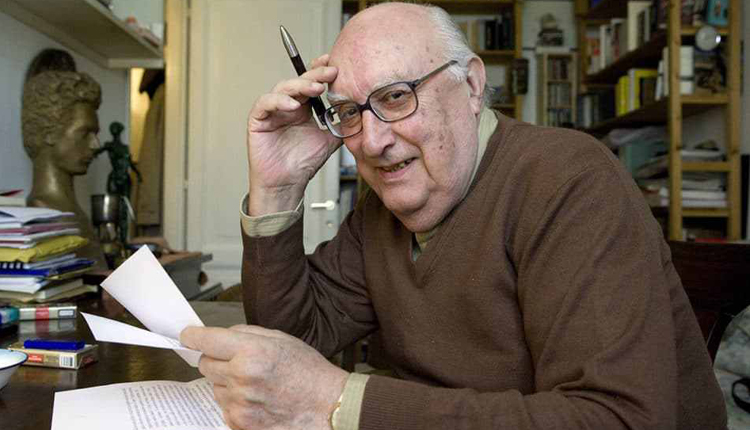Andrea Camilleri, the Sicilian author behind the popular Inspector Montalbano television series, has died aged 93.
One of Italy’s best-loved writers, he had been admitted to a hospital in Rome last month after a cardiac arrest.
The crime writer was best-known for his detective books starring inspector Salvo Montalbano based in the fictional Sicilian town of Vigàta.
The adapted Rai TV series was loved in Italy and became popular in the UK, US, France, Spain, Germany and Australia.
Camilleri lost his sight in recent years but said in 2017 it had allowed him to picture things more clearly.
“I am blind, but losing my sight made all my other senses come back to life,” he said. “They have come to the rescue. My memory has improved, and I remember more things than before with great lucidity, and I still write.”
He turned violence into humour
Camilleri and Inspector Montalbano changed people’s minds about Sicily.
Together, over a period of 25 years, they transformed a grim landscape of mobsters and mafia violence to a light-hearted, humorous, food-focused near-paradise of an imaginary town called Vigàta.
No other mystery plots have narrated the Sicilian “gioia di vivere” (joy of life) so effectively and with such a colourful protagonist: a detective whose days involve morning swims, spaghetti with clams and an onslaught of hilarious malapropisms from an illiterate receptionist at the local police station.
Where else can you find a coroner with a secret passion for cannoli, the cream-filled tubes of Italian pastry.
For London-based Sicilian writer Simonetta Agnello Hornby, Camilleri is “by far the greatest Sicilian writer since the Second World War”.
“He should have been put forward for the Nobel prize,” she said, adding that he was “a man of great intellect, of immense culture and strong and unwavering left-wing principles that, if anything, grew over the years”.
“His passion for justice and support of those less fortunate, be they poor Italians or refugees or boatmen coming from Africa, never wavered.”
How Camilleri wove fact into fiction
Camilleri wrote more than 100 books. His stories were fiction, but influenced by current affairs or the result of hours of scouring the archives.
The Montalbano novels, each of them published in a 180-page format – 18 chapters of 10 pages – have achieved worldwide sales of 25 million and have been translated into 120 languages.
His most recent, Alcyon’s Cook, was published in May in Italy and quickly became a bestseller.
Camilleri’s final book in the series, entitled Riccardino and written in 2006, remains with his publisher, locked in a cabinet in Palermo under agreement that it be printed at a later date.
The writer’s fame was amplified when his stories were adapted for television: his 24 novels and 10 short stories were made into 34 episodes and distributed in some 60 countries to date.
The Montalbano TV mysteries, first broadcast in May 1999, celebrated their 20th anniversary last month.
How Montalbano captured the Italian imagination
Italians’ interest in the character of Salvo Montalbano was ignited with The Shape of the Water, published in Sicily by Sellerio in 1994. At that time, Camilleri was already a 67-year-old pensioner having left a successful career as a director and TV author.
Readers quickly developed a fondness for Montalbano because of his values: a policeman with an high sense of respect for people, with impeccable honesty and a strong dislike for bureaucracy.
They grew to admire his relatable humility, his stubbornness, his grouchy approach and his solitary spirit – he loves eating alone, in silence.
Through his books, Italian readers also got the opportunity to rediscover the importance of Sicilian dialect.
Camilleri’s use of Sicilian expressions – infusing the Italian language with Sicilian mother tongue – helped promote the island’s culture, making people rethink their history.
In Sicily, his work is now studied in schools.
The character of Catarella – the comical illiterate police officer who talks incomprehensively in a mix of bureaucratic Italian and dialect – is amusing both in Italian and in English, as translated by Stephen Sartarelli.
Montalbano seizes the imagination of a wide audience with descriptions of the picturesque seafront in the fictional Vigàta, the view from the terrace of the detective’s house, the culinary surprises of his housekeeper, Adelina, and the feasts at the restaurant Calogero.
Every detail is both real and imaginative. One of Camilleri’s early introductions to literature was Alice’s Adventures in Wonderland by Lewis Carroll, which was read to him by his grandmother.
The ‘Montalbano effect’
Sicily has been a popular tourist destination for years, but the so-called “Montalbano effect” has been credited with boosting tourism on the island.
The entire area of Ragusa – where cities such as Noto, Modica and Scicli are locations for the TV series – features beautiful baroque buildings and is home to a number of Unesco World Heritage sites.
Comiso airport in Ragusa has, since 2013, served two flights a week from London Stansted.
Source: BBC



